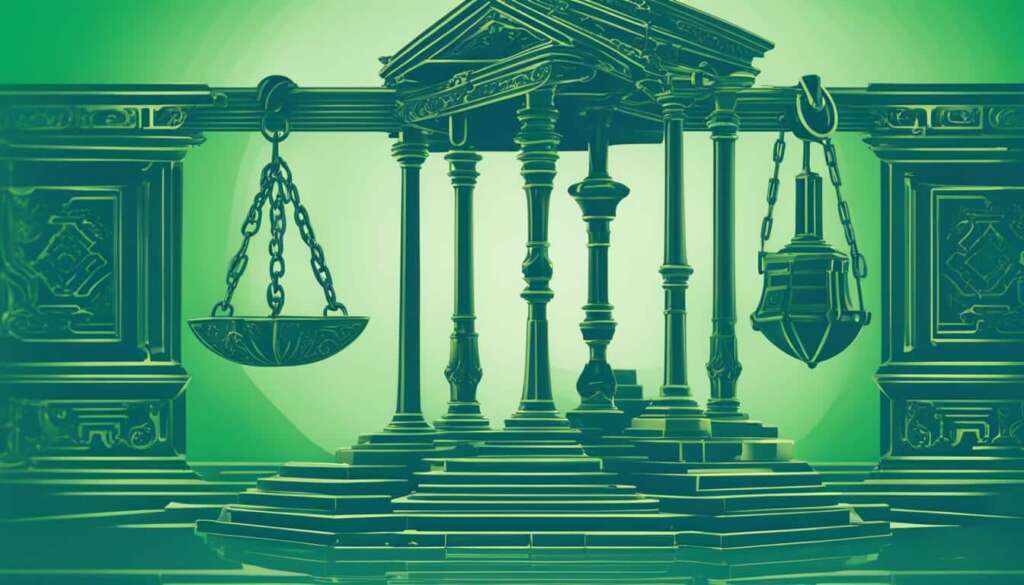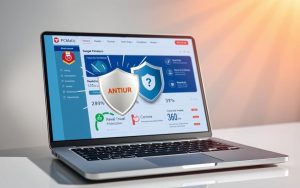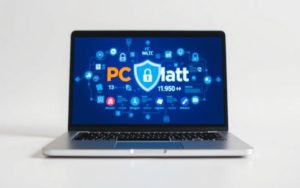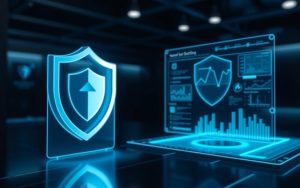Table of Contents
In the digital era, protecting sensitive data from cyber threats has become a top priority for organizations worldwide. This is where the intersection of cybersecurity and privacy laws comes into play. Cybersecurity focuses on securing IT systems and networks from cyber-attacks, while privacy laws impose regulations on organizations handling personal data. Compliance with privacy laws ensures comprehensive cybersecurity measures, making it imperative for businesses to navigate the complexities of cybersecurity and privacy legislation, data protection laws, and information security regulations.
With the increasing reliance on digital platforms and the interconnectedness of global networks, organizations must understand the importance of aligning their cybersecurity efforts with privacy laws. Privacy laws serve as a safeguard to protect personal information from unauthorized access, while cybersecurity laws focus on mitigating cyber risks and maintaining data privacy compliance.
By embracing both legal requirements and proactive cybersecurity strategies, organizations can enhance their cyber risk management practices, ensure data privacy compliance, and safeguard their IT systems from potential cyber threats. This comprehensive approach is essential for building trust with stakeholders and complying with evolving privacy laws and cybersecurity measures.
Overview of Privacy Laws and Cybersecurity
Privacy laws and cybersecurity are two intertwined areas that play a crucial role in protecting sensitive data and ensuring the integrity of digital systems. Privacy laws, such as the General Data Protection Regulation (GDPR) in Europe and the California Consumer Privacy Act (CCPA) in the United States, impose regulations on organizations that handle personal data. These laws stipulate the rights of individuals and the responsibilities of data controllers and processors.
Compliance with privacy laws not only involves safeguarding personal information but also encompasses implementing robust cybersecurity measures. Cyber risk management is an essential aspect of data privacy compliance. Organizations must proactively address potential vulnerabilities and threats to their IT systems and networks to protect against unauthorized access, data breaches, and cyber-attacks.
Cybersecurity laws, on the other hand, provide a legal framework for protecting digital infrastructure and combating cyber threats. These laws outline the obligations and responsibilities of organizations in relation to cybersecurity. For example, the European Union’s Network and Information Security Directive (NIS Directive) requires certain organizations to implement appropriate security measures and report significant cyber incidents.
Key Points:
- Privacy laws regulate the handling of personal data, while cybersecurity laws focus on protecting digital systems from cyber threats.
- Compliance with privacy laws ensures the implementation of comprehensive cybersecurity measures.
- Cyber risk management is vital for data privacy compliance and mitigating cyber threats.
By understanding the intersection of privacy laws and cybersecurity, organizations can take a holistic approach to data protection. It is crucial to stay up to date with evolving privacy regulations and cybersecurity laws to adapt proactive strategies that address emerging threats effectively.
| Privacy Laws | Cybersecurity Laws |
|---|---|
| General Data Protection Regulation (GDPR) | Network and Information Security (NIS) Directive |
| California Consumer Privacy Act (CCPA) | California Consumer Privacy Act (CCPA) |
| Personal Data Protection Act (PDPA) | Data Protection Act 2018 |
Table: Examples of Privacy Laws and Cybersecurity Laws
Legal Challenges
The intersection of global privacy regulations and cybersecurity presents various legal challenges for organizations operating in multiple jurisdictions. With each country or region having its own set of privacy laws, organizations must navigate the complexities of compliance to protect data and privacy rights.
One of the key challenges is liability assessment in the event of a data breach. Determining who is accountable can be a complex process involving multiple parties, including the organization itself, its employees, and third-party vendors. This requires a thorough examination of contractual agreements, security protocols, and data handling practices to allocate responsibility fairly.
Moreover, organizations often face the challenge of balancing data protection and privacy rights. While cybersecurity measures aim to safeguard data from breaches and attacks, privacy laws may impose restrictions on data processing and sharing. Striking a balance between these two aspects is crucial to ensure compliance with regulations while maintaining robust cybersecurity practices.
Global Privacy Regulations
Global privacy regulations add another layer of complexity for organizations. The General Data Protection Regulation (GDPR) in the European Union, for example, has extraterritorial reach, requiring organizations worldwide to comply with its stringent data protection requirements. Failure to adhere to these regulations can result in significant fines and reputational damage.
Organizations must stay updated with the evolving landscape of global privacy regulations to ensure compliance and mitigate legal risks. This requires ongoing monitoring of legislative changes and adapting internal policies and procedures accordingly. By proactively addressing legal challenges related to privacy and cybersecurity, organizations can navigate the complex regulatory environment and protect sensitive data while respecting privacy rights.
| Legal Challenges | Solutions |
|---|---|
| 1. Lack of uniformity in privacy regulations across jurisdictions | Regularly review and update policies to comply with relevant regulations in each jurisdiction. |
| 2. Determining liability in the event of a data breach | Conduct thorough assessments of contractual agreements and data handling practices to allocate responsibility fairly. |
| 3. Balancing data protection and privacy rights | Develop comprehensive policies and procedures that take into account both cybersecurity measures and privacy obligations. |
| 4. Compliance with global privacy regulations | Maintain a proactive approach by monitoring legislative changes and adapting internal policies accordingly. |
By addressing these legal challenges, organizations can ensure they meet their obligations under global privacy regulations, mitigate legal risks, and build trust with stakeholders.
Impacts of Data Breaches
Data breaches have become a significant concern for organizations in today’s digital landscape. Not only do they have serious implications for cybersecurity, but they also have far-reaching consequences for privacy laws. When a data breach occurs, organizations face legal liability, reputational damage, and regulatory investigations that can result in hefty fines and penalties. Therefore, it is vital for businesses to understand the impacts of data breaches and take proactive measures to prevent and address them.
One key aspect of data breach management is compliance with data breach notification requirements. In some jurisdictions, such as those governed by the General Data Protection Regulation (GDPR), organizations are required to notify affected individuals and relevant authorities within a specific timeframe after discovering a breach. Failure to comply with these notification requirements can result in severe penalties, further exacerbating the legal fallout from a breach. Therefore, organizations must have robust processes and systems in place to ensure timely and accurate notifications in the event of a breach.
“Data breaches not only put organizations at risk of financial and reputational loss but also expose individuals to the potential misuse of their personal information. Promptly notifying affected individuals is crucial for preserving their rights and giving them an opportunity to take necessary actions to protect themselves,” said cybersecurity expert John Smith.
Data Breach Notification Requirements under GDPR
Under the GDPR, organizations must notify the relevant supervisory authority within 72 hours of becoming aware of a data breach, unless the breach is unlikely to result in a risk to individuals’ rights and freedoms. The notification must include details such as the nature of the breach, the categories of personal data affected, the estimated number of individuals affected, and the measures taken or proposed to mitigate the breach’s impact. Additionally, if the breach is likely to result in a high risk to individuals’ rights and freedoms, organizations must also notify the affected individuals directly.
Complying with GDPR’s data breach notification requirements is not only a legal obligation but also a crucial step towards maintaining trust with customers and stakeholders. Prompt and transparent communication shows a commitment to data protection and can help mitigate reputational damage. It also provides affected individuals with the necessary information to protect themselves from the potential consequences of the breach.
| Legal Fallout from Data Breaches | Implications |
|---|---|
| Financial Losses | Organizations may face significant financial penalties, compensation claims, and costs of remediation. |
| Reputational Damage | Data breaches erode customer trust and can result in a loss of business, negative media coverage, and damage to brand reputation. |
| Regulatory Investigations | Regulatory authorities may conduct investigations to assess compliance with privacy laws and impose additional sanctions if violations are identified. |
As the frequency and sophistication of data breaches continue to rise, organizations must prioritize cybersecurity and compliance with privacy laws. Implementing robust security measures, conducting regular risk assessments, and staying up-to-date with data breach notification requirements are essential steps in protecting both sensitive information and the organization’s reputation.

Emerging Technologies
As the world becomes increasingly digital, emerging technologies play a significant role in shaping the landscape of privacy laws and cybersecurity. Two key technologies that have been gaining traction in recent years are blockchain technology and biometric authentication. These advancements offer enhanced data security and verification methods, addressing key concerns in both privacy and cybersecurity domains.
Blockchain technology, most commonly associated with cryptocurrencies like Bitcoin, is a decentralized and tamper-proof ledger system. Its unique architecture ensures that data stored within a blockchain cannot be altered or manipulated without leaving a trace. This technology provides a high level of security and transparency, making it particularly useful for safeguarding sensitive information. Its immutable nature significantly reduces the risk of data breaches.
Biometric authentication, on the other hand, utilizes a person’s unique physical or behavioral attributes, such as fingerprints or facial recognition, for identity verification. Biometric data is difficult to replicate, providing a robust layer of security. As privacy laws continue to evolve, biometric authentication offers a viable option for organizations to comply with stringent data protection regulations while ensuring secure access to sensitive information.
| Technology | Benefits |
|---|---|
| Blockchain | – Immutable and tamper-proof data storage – Enhanced transparency and accountability – Reduced risk of data breaches |
| Biometric Authentication | – High level of security – Difficult to replicate or forge – Compliance with privacy laws |
As these emerging technologies gain prominence, privacy laws are evolving to keep pace with the changing landscape. Governments and regulatory bodies are recognizing the potential of blockchain technology and are exploring its applicability in various sectors, including finance, healthcare, and supply chain management. Privacy laws now encompass provisions that address the unique challenges and opportunities presented by these technologies, enabling organizations to leverage their benefits while safeguarding sensitive information.
It is vital for organizations to stay informed about these evolving privacy laws and assess how emerging technologies can augment their cybersecurity efforts. By embracing blockchain technology and employing biometric authentication methods, organizations can enhance their data security measures and build trust with their stakeholders, all while adhering to privacy laws and regulations.
Best Practices
Implementing best practices is essential for organizations to ensure compliance with privacy laws and maintain strong cybersecurity practices. By following these guidelines, businesses can mitigate the risks of data breaches and other cyber threats.
1. Conduct Risk Assessments:
Regular risk assessments help identify vulnerabilities in the organization’s IT systems and networks. This process involves evaluating potential risks, assessing their impact, and implementing appropriate controls to minimize vulnerabilities. By regularly conducting risk assessments, organizations can proactively address cybersecurity and privacy risks.
2. Implement Access Controls:
Strong access controls are crucial for protecting sensitive data. Organizations should implement measures such as multi-factor authentication, role-based access control, and regular access reviews. These controls ensure that only authorized individuals have access to sensitive information, reducing the risk of unauthorized access or data breaches.
3. Develop an Incident Response Plan:
An incident response plan outlines the procedures to be followed in the event of a data breach or cybersecurity incident. It should include steps for identifying, containing, and resolving the incident, as well as communication protocols and legal obligations. Regular testing and updating of the plan help ensure an effective response when a breach occurs.
4. Regularly Update Privacy Policies:
Privacy policies should be reviewed and updated regularly to reflect changes in privacy laws and industry best practices. Organizations should clearly communicate their data handling practices, including how personal information is collected, stored, and shared. Transparency is key to building trust with customers and demonstrating compliance with privacy regulations.
5. Provide Employee Training:
Employees play a critical role in maintaining cybersecurity and privacy practices within an organization. Regular training sessions should be conducted to educate employees on best practices, such as identifying phishing attempts, handling sensitive information, and following data protection protocols. A well-informed workforce is an essential defense against cyber threats.
By following these best practices, organizations can strengthen their cybersecurity posture, ensure compliance with privacy laws, and protect sensitive information from cyber threats. Prioritizing risk assessments, access controls, incident response planning, privacy policy updates, and employee training is crucial for maintaining robust data protection measures.
Conclusion
In today’s digital age, protecting sensitive information is of critical importance. Finding the right balance between cybersecurity and privacy is essential to ensure regulatory compliance and foster trust with customers and stakeholders. By following best practices, conducting regular risk assessments, implementing robust access controls, having an effective incident response plan, updating privacy policies, and providing comprehensive employee training, organisations can effectively mitigate the risks of data breaches and other cyber threats. Prioritising cybersecurity and privacy as integral parts of business strategy is key to long-term success and maintaining a strong reputation.
Compliance with cybersecurity and privacy regulations is not only a legal requirement but also a way to safeguard data and demonstrate commitment to protecting customer information. Comprehensive data protection measures, including encryption, strong authentication protocols, and regular vulnerability assessments, can help organisations stay ahead of emerging threats. By integrating cybersecurity and privacy practices into their operations, businesses can build trust with customers and stakeholders, who are increasingly concerned about the security of their personal information.
Trust-building with stakeholders goes beyond mere compliance. It involves fostering transparency and accountability in handling personal data. Implementing clear privacy policies and notices, explaining how data is collected, used, and protected, can create a sense of transparency and reassure customers. Regular updates to privacy policies and employee training programs are essential to keep up with evolving privacy laws and ensure that employees understand their responsibilities in safeguarding data and preventing breaches. By taking these proactive steps, organisations can establish trust and credibility, which are vital in today’s data-driven business landscape.
Overall, cybersecurity and privacy compliance are crucial for protecting sensitive data and maintaining trust with customers and stakeholders. By integrating robust cybersecurity measures, following privacy laws, and prioritising data protection, organisations can navigate the complex landscape of security threats and regulatory requirements. By investing in cybersecurity and privacy as core components of their business strategy, organisations can not only mitigate risks but also build a strong foundation for long-term success and reputation in the digital age.
FAQ
What is the intersection between cybersecurity and privacy laws?
The intersection between cybersecurity and privacy laws refers to the overlap in protecting sensitive data from cyber threats. Privacy laws impose regulations on organizations handling personal data, while cybersecurity aims to secure IT systems and networks from cyber-attacks.
Why is compliance with privacy laws important for cybersecurity?
Compliance with privacy laws is crucial for cybersecurity because it requires organizations to implement strong measures to protect personal information from unauthorized access. This helps safeguard data from breaches and attacks like hacking or phishing.
What challenges do organizations face due to different privacy regulations?
Organizations operating globally face challenges due to the lack of uniformity in privacy regulations across countries and regions. Determining liability in the event of a data breach becomes complex, as it may fall on the organization, its employees, or third-party vendors.
How do data breaches impact privacy laws and cybersecurity?
Data breaches have significant impacts on both privacy laws and cybersecurity. Breached organizations may face legal liability, reputational damage, and regulatory investigations. Compliance with data breach notification requirements, such as those under the GDPR, is crucial.
How are emerging technologies changing privacy laws and cybersecurity?
Emerging technologies like blockchain and biometric authentication are changing the landscape of privacy laws and cybersecurity. These technologies offer enhanced data security and verification. Privacy laws are evolving to introduce new requirements for data protection.
What are the best practices for ensuring cybersecurity and privacy compliance?
To ensure compliance with privacy laws and maintain strong cybersecurity practices, organizations should conduct regular risk assessments, implement strict access controls such as multi-factor authentication, have a comprehensive incident response plan, update privacy policies, and provide employee training on best practices.
Why is prioritizing cybersecurity and privacy important for organizations?
Prioritizing cybersecurity and privacy as core components of business strategy is essential for regulatory compliance and building trust with customers and stakeholders. By following best practices and mitigating the risks of data breaches and cyber threats, organizations can protect sensitive information in the digital age.
Source Links
- https://originstamp.com/blog/the-intersection-of-privacy-laws-and-cybersecurity/
- https://resources.infosecinstitute.com/topics/management-compliance-auditing/u-s-privacy-and-cybersecurity-laws-an-overview/
- https://medium.com/@tdx.social/the-intersection-of-cybersecurity-and-privacy-finding-a-balance-634b67727a45









